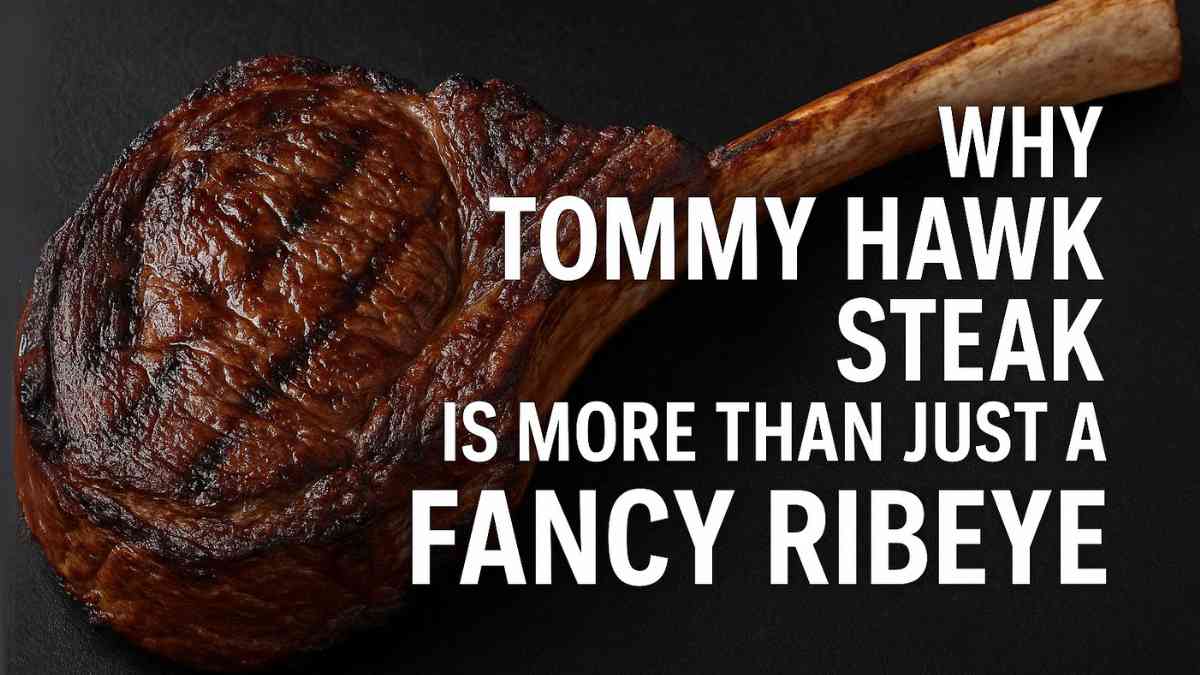Why Tommy Hawk Steak Is More Than Just a Fancy Ribeye

The Tommy Hawk Steak has taken center stage in both upscale restaurants and backyard barbecues. Often mistaken for a regular ribeye with a handle, this impressive cut of beef is far more than a visual statement. It combines heritage, flavor, and culinary craftsmanship into a single, bone-in masterpiece. But what makes it stand apart from its ribeye sibling? And why are chefs and food lovers around the world obsessed with it?
What is a Tommy Hawk Steak?
The Tommy Hawk Steak, commonly referred to by its traditional name, “Tomahawk Steak,” is a bone-in ribeye with an extra-long rib bone left intact. This long bone, typically 6 to 8 inches, is frenched to give it the look of a tomahawk axe. This dramatic presentation has made it a favorite for those looking to serve a steak that not only tastes great but commands attention. Despite its resemblance to a standard ribeye, the Tommy Hawk is a deeper culinary experience.
Where the Cut Comes From
The steak is cut from the rib primal section of the cow, which includes ribs six through twelve. What makes it unique is not just the long bone, but also the thickness of the meat—often around 2 inches. This cut includes the longissimus dorsi (ribeye muscle), along with parts of the spinalis (ribeye cap), which is widely considered one of the most flavorful parts of a cow.
It’s Not Just About Looks
At first glance, it might appear the Tommy Hawk Steak is all about aesthetics. The presentation is theatrical—something you’d expect at a fine dining restaurant or a food influencer’s table. However, this steak has substance to match its style. The intramuscular fat, or marbling, in this cut ensures a rich, juicy, and tender texture. Unlike leaner cuts, the marbling provides a buttery mouthfeel and enhances flavor as it renders during cooking.
Flavor That Goes Deeper
What truly sets the Tommy Hawk Steak apart is its flavor profile. The bone acts as a flavor conductor, allowing the meat closest to it to absorb and retain additional richness. This makes every bite closer to the bone more intense and satisfying. The thickness of the cut also ensures that the meat retains juices better and allows for a more gradual cook, resulting in an evenly distributed internal doneness.
How to Cook It Right
Cooking a Tommy Hawk Steak isn’t like searing a quick filet or grilling thin cuts. It demands attention, patience, and the right technique. One of the most popular methods is the reverse sear. This involves slowly roasting the steak in an oven or on a grill over indirect heat until it reaches an internal temperature of around 115°F. Then, it’s seared over high heat (either on a grill or cast-iron skillet) to create a caramelized crust.
Another method that has gained popularity is sous vide followed by a sear. This allows for precise temperature control and an incredibly tender texture. Whichever method you choose, allowing the steak to rest after cooking is essential. This helps redistribute the juices and keeps the meat moist and flavorful.
Nutritional Benefits
Tommy Hawk Steak is more than a feast for the senses. It also offers nutritional value. It is a rich source of high-quality protein, supporting muscle maintenance and recovery. It also contains significant amounts of iron, zinc, vitamin B12, and niacin, essential for blood health and energy metabolism. That said, due to its high fat content, it’s best enjoyed in moderation and balanced with lighter, fiber-rich side dishes.
Where to Find It
While originally a specialty cut found mostly in high-end steakhouses, Tommy Hawk Steak is now widely available. Gourmet butchers, online meat markets, and premium grocery stores often carry it. Look for labels like USDA Prime, Angus, or even Wagyu for the best quality. The price typically ranges from $25 to $50+ per steak, depending on weight and grade.
Home or Restaurant?
You don’t need a Michelin star to enjoy this steak. While it’s a staple at upscale restaurants, many home cooks are finding ways to prepare it at home with excellent results. What you do need is the right equipment (a meat thermometer, heavy pan or grill, and tongs), patience, and respect for the cut.
A Cultural Icon
Beyond its culinary reputation, the Tommy Hawk Steak has become a cultural symbol of indulgence and craftsmanship. It’s frequently seen on food shows, in social media reels, and in celebratory meals. In Texas, lawmakers even proposed making the Tomahawk Ribeye the official state steak, further proving its impact.
Tommy Hawk vs. Ribeye: What’s the Real Difference?
While both cuts come from the same rib section, the key differences lie in presentation, thickness, and cooking style. The Tommy Hawk is typically much thicker and retains the long bone, which affects both flavor and visual impact. A standard ribeye is boneless or has a shorter bone and cooks faster, making it more convenient but arguably less dramatic in experience.
Pairings That Work
Because of its richness, the Tommy Hawk pairs well with bold red wines such as Cabernet Sauvignon, Syrah, or Malbec. Classic sides like garlic mashed potatoes, charred asparagus, or grilled corn complement its hearty flavor without overpowering it. A finishing touch of garlic herb butter elevates the flavor even more.
How to Choose the Best One
Look for steaks with even marbling, bright red color, and a firm texture. The bone should be clean and dry. Opt for cuts that are at least 2 inches thick for better control while cooking. USDA Prime offers superior marbling, while Wagyu brings an entirely different level of tenderness and flavor intensity.
Not Just a Meal, but a Moment
Serving a Tommy Hawk Steak isn’t just about feeding people—it’s about creating a memorable experience. Whether it’s for a birthday dinner, a romantic evening, or a weekend grill party, the moment it hits the table, all eyes are drawn to it. It invites conversation, admiration, and appetite.
Conclusion
The Tommy Hawk Steak is more than a trending food item or a piece of meat with a bone. It’s a celebration of flavor, history, and culinary art. Whether you’re a seasoned grill master or a curious beginner, this steak offers an opportunity to create something unforgettable. It stands at the crossroads of tradition and modern food culture—a true star in the world of beef.
Fire up your grill and let the Tommy Hawk steal the show.



